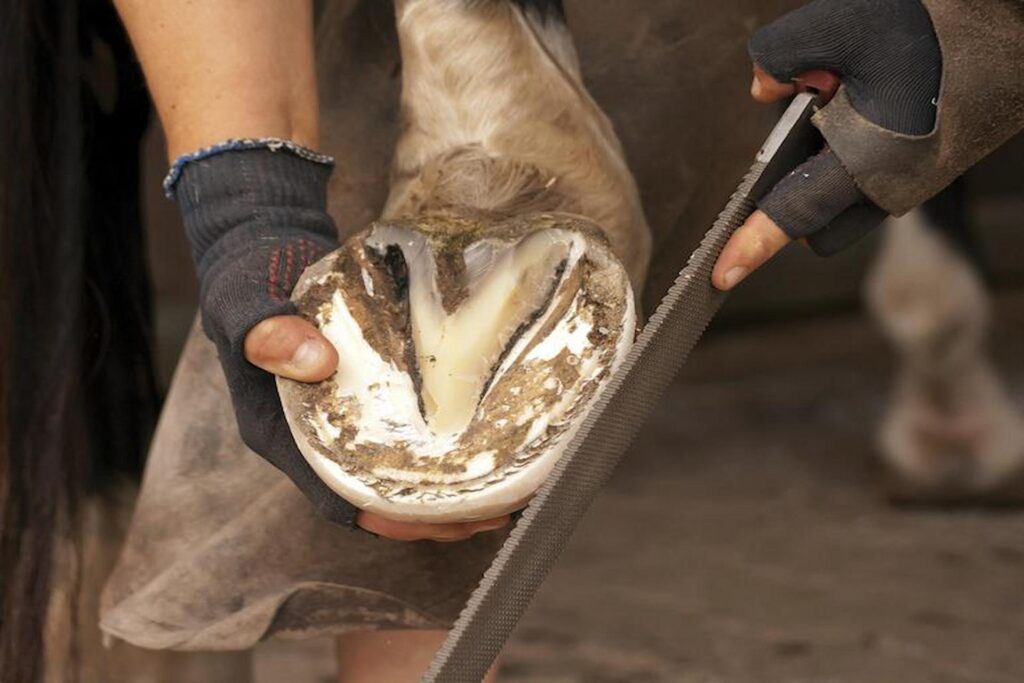Laminitis is a condition that affects a horse’s hooves. It can be painful and debilitating and have a profound impact on their quality of life. Laminitis can affect any horse, but there is a link between this condition and obesity. There are a few ways in which having an overweight horse can lead to laminitis developing, which we’ll take a closer look at below, as well as ways in which you can manage your horse’s weight – from feeding high-fibre forage to implementing a suitable exercise regime.
What is laminitis?
Most horse owners will be aware of laminitis and the impact it can have on health and well-being. Laminitis affects the soft tissues – the laminae – that connect the pedal bone to the hoof wall. The laminae can become inflamed, and start to detach from the hoof wall, which can be incredibly painful and debilitating for the horse. There are a few different signs of laminitis to look out for, which include lameness, heat within the hooves, an increased digital pulse, or if your horse is in visible pain, shifting from one foot to the other. If you notice any of these signs, you should consult with your vet to confirm and manage the condition.
Common causes
So, what causes this condition to take hold? There are various factors which can increase the risk of laminitis, and these are some of the most common:
Diet: An abrupt change in diet, or overconsumption of carbohydrates or sugar can increase the risk of laminitis.
Metabolic problems: If your horse suffers from a condition like PPID and EMS, they are more likely to suffer from laminitis.
Trauma: If your horse has suffered repeated trauma to the hoof, for example, with excessive exercise on hard ground, this could also lead to laminitis.
Illness or infection: Systemic infections, illnesses and even severe colic can increase the risk of this condition.
The link between laminitis and obesity
Obesity and laminitis are closely linked, and it’s thought that this is one of the main causes of the condition. Here are a few ways in which laminitis and obesity are connected:
Insulin resistance
Obesity in horses can lead to insulin resistance, which is now more commonly referred to as insulin dysregulation. This means that the horse’s body has a lower response to insulin. Insulin is a hormone which regulates blood sugar levels, which means your horse may suffer from higher levels of glucose in the bloodstream.
High levels of insulin
As a result of insulin dysregulation, your horse’s body may produce more insulin to compensate for the higher levels of glucose in the bloodstream. This can then increase the risk of laminitis.
Fat accumulation
If your horse is overweight or obese, you may notice they have fat deposits around the body, particularly across the tailhead and crest of the neck. These fatty deposits can produce inflammatory molecules, called adipokines, that may be linked to the development of laminitis.
Inflammation
Being overweight or obese can itself lead to your horse being in a state of systemic low-grade inflammation. This could have an impact on various tissues around the body, including the laminae within the hooves, potentially increasing the risk of laminitis in conjunction with the effects of insulin dysregulation. Excess bodyweight load on the hooves may also play a role.
Managing obesity-related laminitis
If you suspect your horse is overweight or obese, and therefore at higher risk of developing laminitis, there are a few ways in which you can manage this, including:
Nutrition: Focus on your horse’s nutrition and provide them with a well-balanced but low energy (calorie) diet to manage its weight. You can do this by providing a high-fibre forage alongside an appropriate balancer or vitamin and mineral supplement . You should also avoid cereal-based feeds that are high in sugar and starch – instead, choose a feed specially formulated for overweight horses. Make sure you make all dietary changes gradually.
Exercise: Create an exercise plan to help your horse lose excess weight and maintain a healthy condition. You could consult with your vet for advice, especially if your horse suffers from any musculoskeletal issues that may limit the amount of exercise they can undertake.
Monitor weight: Be sure to fat score your horse regularly to determine any changes. This will allow you to adjust its diet and exercise regime as necessary.
Pasture management: If your horse has access to pasture, think about limiting this to reduce overconsumption of grass, especially in early spring and summer when it’s likely to be higher in sugar. Use grazing muzzles, strip graze or limit turnout time on lush pasture.

